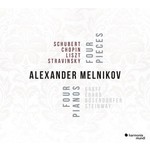
Schubert / Chopin / Liszt / Stravinsky: Four Pianos - Four Pieces
 $35.00
In Stock
add to cart
$35.00
In Stock
add to cart
SCHUBERT / CHOPIN / LISZT / STRAVINSKY
Schubert / Chopin / Liszt / Stravinsky: Four Pianos - Four Pieces
Alexander Melnikov (pianos)
[ Harmonia Mundi / CD ]
Release Date: Monday 9 April 2018
Alexander Melnikov imagined this programme where four monuments from the piano repertoire are interpreted in their original instrumental environment. The four pianos chosen have characteristics corresponding to those of the instruments on which these virtuoso pieces were first performed. A journey where the horizons of sounds expand to dizzying new heights.
Gramophone Award Nomination 2018 - Instrumental
"I don't know of an orchestral performance of [Petrouchka] that evokes the title character with greater sympathy and pathos than Melnikov achieves… Nor can I think of recorded performances of either Liszt's or Stravinsky's benchmark creations more compelling than these…Melnikov's prevalent richness of detail, unforced but precise rhetoric and exquisite sense of colour are skilfully captured by the engineers." Gramophone Editor's Choice April 2018
"He makes good use of the tonal differences between registers on the Graff in the Wanderer Fantasy and exploits the light touch of the Érard to brilliant effect in the more bravura Chopin studies, while the Bösendorfer (missing from the London recital) produces a leaner sound than the maker's later instruments." The Guardian
Tracks:
Franz SCHUBERT (1797-1828)
"Wanderer-Fantasie D.760, op. 15
C major / Ut majeur / C-Dur" 20'00
1 I. Allegro con fuoco ma non troppo 5'41
2 II. Adagio 6'01
3 III. Presto 4'34
4 IV. Allegro 3'44
Alois Graff piano, Vienna ca. 1835, restored by Edwin Beunk (A. Melnikov's collection).
Traditional "Viennese action" with leather covered hammer heads. Keyboard compass: 6 1/2 octaves, CC-g4. 5 pedals, una-corda, bassoon register, raise the damping, moderator and drum/bells.
Frédéric CHOPIN (1810-1849)
"Douze Études op. 10" 25'32
5 N° 1. Allegro (C major / Ut majeur / C-Dur) 1'49
6 N° 2. Allegro (A minor / la mineur / a-Moll) 1'23
7 N° 3. Lento ma non troppo (E major / Mi majeur / E-Dur) 3'11
8 N° 4. Presto (C sharp minor / ut dièse mineur / cis-Moll) 1'55
9 N° 5. Vivace. Brillante (G flat major / Sol bémol majeur / Ges-Dur) 1'40
10 N° 6. Andante. Con molto espressione (E flat minor / mi bémol mineur / es-Moll) 2'42
11 N° 7. Vivace (C major / Ut majeur / C-Dur) 1'33
12 N° 8. Allegro (F major / Fa majeur / F-Dur) 2'20
13 N° 9. Allegro molto agitato (F minor / fa mineur / f-Moll) 1'53
14 N° 10. Vivace assai (A flat major / La bémol majeur / As-Dur) 2'11
15 N° 11. Allegretto (E flat major / Mi bémol majeur / Es-Dur) 2'19
16 N° 12. Allegro con fuoco (C minor / ut mineur / c-Moll) 2'36
Érard piano, Paris 1837, Edwin Beunk's collection.
Érard patent "repetition action", the hammers covered with felt. Keyboard compass: 6 3/4 octaves, CC-a4 (originally CC-f4), extra keys added in the 1880's.
Franz LISZT (1811-1886)
Grande Fantaisie (réminiscences) de Don Juan S.418 18'09
17 I. Grave 4'31
18 II. Duetto. Andantino 3'05
19 III. Variazione 1 3'36
20 IV. Variazione 2. Tempo giusto 3'41
21 V. Quasi Presto. Tempo deciso 3'16
Bösendorfer piano, Vienna ca. 1875, restaured by Edwin Beunk (A. Melnikov's collection).
It has a traditional "Viennese action", the hammers covered with felt and leather on top. Keyboard compass 7 octaves, AAA-a4.
Igor STRAVINSKY (1882-1971)
Trois Mouvements de Pétrouchka 15'37
22 I. Danse russe 2'37
23 II. Chez Pétrouchka 4'34
24 III. La Semaine grasse 8'26
Steinway piano, 2014